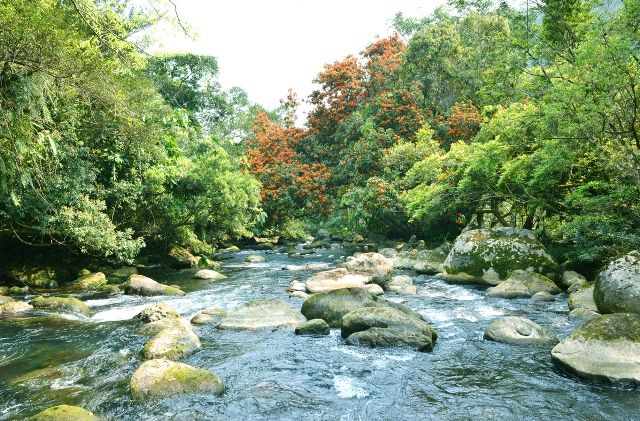Currently, the Government of Vietnam has submitted a dossier of application Cultural Organization – Science and Education of the United Nations (UNESCO) recognized the Phong Nha – Ke Bang
Currently, the Government of Vietnam has submitted a dossier of application Cultural Organization – Science and Education of the United Nations (UNESCO) recognized the Phong Nha – Ke Bang National Park as a World Natural Heritage 2nd pepper press X: (Criteria for biodiversity): ” there is a special value on biodiversity, including endangered species of global significance for science and conservation ”.
National Park Phong Nha – Ke Bang is the meaning Karst important not only valuable in terms of geology and geomorphology, which dwells on values such as biodiversity of global importance. National Park Phong Nha – Ke Bang National Park is located in the middle of Central Point is the place to be rated as one of the 200 centers of biodiversity in the world (WWF, 2000).
Springs Trailer Park Phong Nha – Ke Bang
National Park Phong Nha – Ke Bang is evergreen to 96.2% coverage area, including primary forest occupies less affected 92.2% of the total area. Can confirm that this is a national park with a coverage rate of primary forests and the largest in the system of special-use forests in Vietnam. Especially the past we have found a rocky green Botanical species (calocedrus rupestris) that under the canopy is the Paphiopedilum species Venus (Paphiopedilum spp) allocation of limestone at an altitude of 700m -1000m. Located at km 37 the 20 Wins Decision turn towards the South is a forest green cypress pure an area of 2400 hectares. Here there are tall trees from 20 – 30m. According to scientists, forest green Bach in Phong Nha – Ke Bang is very rare, and only exist in Vietnam limestone, with many trees older than 500 years, forest green Bach as species at risk extinct in the world.
National Park Phong Nha – Ke Bang National Park which is also embodied in the diversity of natural species. So far, has identified the presence of 2,651 species of vascular plants, 735 species of vertebrates, 369 species of insects. We mostly natural native species in the area. Among them there are 116 plant species and 129 animal species listed in the Vietnam Red Book and IUCN Red List in 2006.
Featuring a variety of limestone habitats, caves, mountains … Phong Nha – Ke Bang is ideal conditions for primates 9/21 (43% of Vietnam primate) live. There are 3 endemic primates of the massif is Voc Ha Tinh, size and brown legs, white-cheeked gibbon, including 1 subspecies are endemic Ha Tinh Voc only found in karst, Phong Nha – Ke Bang and the surrounding area.
With an area of limestone and vegetation vast primeval forests, Phong Nha – Ke Bang is not only interesting but richly diverse group of groups of birds (302 species); groups of reptiles and amphibians (59 species of reptiles and 22 amphibians); group of fish (72 species) and butterflies (261 species). In particular, bat fauna in Phong Nha – Ke Bang National Park in Vietnam most diverse, with 46 species, accounting for 43% of Vietnam’s total species.
For vegetation, the National Park Phong Nha – Ke Bang National Park in the presence of 419 plant species endemic to Vietnam (including 28 orchid species). In addition, the vessel has species (Hopea sp) are to be classified as new species for publication is also endemic to the National Park. Phong Nha – Ke Bang National Park is also home to the two exchanges flora of North and South Vietnam. This is the most southerly boundary of some such northern plants Grinding (Burretiodendron hsienmu), Cho water (Platanus kerrii) … and also the northern boundary of the ends of some southern species such as oil ke (Dipterocarpus kerril), Burners purple (Diptercalpus grandiflorus) … plant composition of national parks is certainly much richer if they are investigated in detail. With such abundance, the plants here contains a gene inexhaustible source.
In recent years, the National Park Phong Nha – Ke Bang is potentially interesting place for scientists to explore. Evidence is only within the past 10 years scientists have discovered one species, one bird species, 6 species of reptiles, one amphibian species, 12 fish species and subspecies, and two new butterfly species course. It can be affirmed, not a protected area is causing attention as Phong Nha – Ke Bang for scientists in recent years.
National Park Phong Nha – Ke Bang National Park is the natural habitat important and most significant for the conservation of biodiversity. The value of biodiversity as well as the underlying values of the National Park Phong Nha – Ke Bang will be very valuable for scientific research work at the same time is very valuable for nature conservation, development Socioeconomic. Therefore, the preservation of heritage Phong Nha – Ke Bang is the important task of not only Vietnam but for all humanity.
BBT







